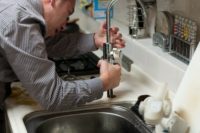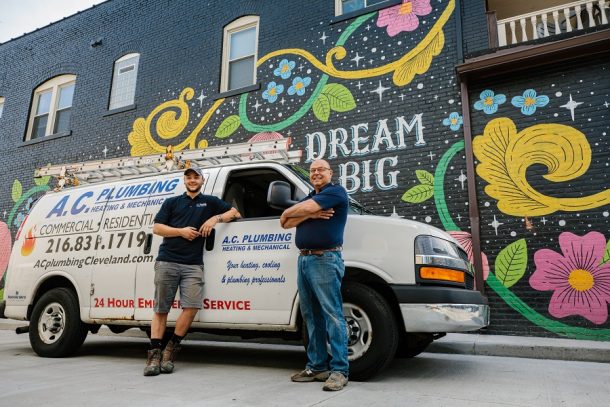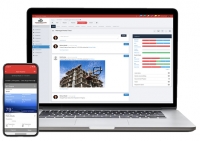New AI-powered solution adjusts advertising spend in real-time based on actual job availability for Scorpion & ServiceTitan clients Scorpion, the leading provider of digital marketing and technology solutions for local businesses, and ServiceTitan, a software platform that powers the trades, announced the launch of Capacity Marketing Engine, a new AI-powered product designed to help home Read more
ROI

New AI-powered solution adjusts advertising spend in real-time based on actual job availability for Scorpion & ServiceTitan clients

Scorpion, the leading provider of digital marketing and technology solutions for local businesses, and ServiceTitan, a software platform that powers the trades, announced the launch of Capacity Marketing Engine, a new AI-powered product designed to help home services providers maximize digital advertising spend, maintain a full schedule, and reduce unnecessary advertising costs. Capacity Marketing Engine is exclusively available to select Scorpion clients now and available for all clients who have purchased Scorpion’s RevenueMAX and ServiceTitan’s Marketing Pro with Ads Optimizer beginning in May.
Home services businesses—such as HVAC companies, plumbers, and electricians—rely on consistent lead generation to fuel growth. However, fluctuating demand, seasonal slowdowns, and the unpredictability of consumer needs can lead to inefficiencies in advertising spending and scheduling. As a result, home services businesses face wasted marketing dollars, missed revenue targets, idle technicians, and unsatisfied customers.
Scorpion’s Capacity Marketing Engine uses AI-powered automation to adjust advertising spend based on real-time business capacity information from ServiceTitan. When demand is low, the system automatically boosts advertising to fill the schedule; when capacity is high, spend is scaled back to avoid overallocation.
With Capacity Marketing Engine, the connection between scheduling and demand fluctuations is now aligned and intuitively directs the advertising strategy for a true ‘smart scheduler.’ Now, home services businesses can redirect their focus to what matters: delivering exceptional service, helping to maximize ROI, and hitting revenue goals.
This launch deepens the strategic partnership between Scorpion and ServiceTitan, combining advanced advertising automation with business data from the industry’s most trusted field service platform. Together, they’re setting a new standard for how home services businesses grow: smarter, faster, and with greater efficiency than ever before.
“For business owners, Capacity Marketing Engine enables investment decisions that directly support profitability and long-term growth,” said Rustin Kretz, Founder and CEO of Scorpion. “We’re proud to launch this with our partners at ServiceTitan—it’s another step toward helping our clients grow more efficiently, stay fully booked, and maximize their revenue.”
Key Benefits of Capacity Marketing Engine:
- Automated Advertising Spend Adjustment: AI-powered technology that increases spend during slower periods and scales back when schedules are full.
- Real-Time Visibility and Control: Built-in transparency through Scorpion’s Revenue App provides a clear, historical log of budget changes and the triggers behind them—so clients always know what’s happening and why.
- Time and Cost Savings: Reduced need for manual ad management, freeing business owners to focus on service delivery.
- Enhanced Marketing Efficiency: Optimized marketing budgets to help generate maximum return on investment and drive consistent growth.
To learn more about Capacity Marketing Engine and how Scorpion and ServiceTitan are transforming growth for home services businesses, visit scorpion.co/capacity-marketing.

Optimizing the efficiency of operations in a plumbing company is crucial for business success. Streamlining processes not only improves service delivery but also boosts profitability and customer satisfaction. Here are ten smart ways to enhance the operational efficiency of your plumbing business. Utilize Modern Technology The integration of modern technology in plumbing operations extends beyond Read more
Optimizing the efficiency of operations in a plumbing company is crucial for business success. Streamlining processes not only improves service delivery but also boosts profitability and customer satisfaction. Here are ten smart ways to enhance the operational efficiency of your plumbing business.

Utilize Modern Technology
The integration of modern technology in plumbing operations extends beyond basic administrative tasks. Today’s advanced plumbing tools, such as video inspection cameras and leak detection equipment, can significantly enhance diagnostic accuracy and job efficiency. In addition, software solutions can manage everything from customer appointments to real-time inventory tracking and employee dispatch. Cloud-based platforms offer the flexibility to access this data from anywhere, providing a critical advantage in responsiveness and decision-making. Embracing these technologies not only streamlines operations but also elevates the level of service offered to customers. By staying abreast of technological advancements, a plumbing business can differentiate itself in a competitive market and offer solutions that are both innovative and customer-centric.
Implement Efficient Scheduling and Dispatch Systems
Efficient scheduling and dispatch systems are more than just organizational tools; they are vital for optimizing the allocation of resources and ensuring customer satisfaction. Modern scheduling software often comes with features like GPS tracking, which helps in real-time monitoring of field personnel. This enables more dynamic scheduling, allowing dispatchers to respond to urgent calls more effectively or adjust schedules to accommodate unexpected delays. By reducing the time technicians spend on the road and ensuring prompt service, these systems can significantly enhance both operational efficiency and customer trust. The result is a more agile, responsive service that can adapt to the day’s demands in real-time.

Standardize Procedures and Best Practices
Standardizing procedures goes hand in hand with ensuring quality control in every aspect of the plumbing service. From the initial assessment of a job to the final quality check, standardized procedures ensure consistency and reliability in service delivery. This could include checklists for job completion or standardized customer follow-up protocols. By having a uniform approach, it becomes easier to train new employees and maintain high standards across the board. Furthermore, a standardized set of best practices helps in establishing a strong brand reputation, as customers begin to recognize and appreciate the consistent quality of service.
Invest in Training and Development
Regular training and development programs are pivotal for keeping the workforce up-to-date with the latest industry standards and technologies. These programs can cover a wide range of topics, from advanced plumbing techniques and new equipment training to soft skills like customer service and communication. Investing in your employees’ growth not only enhances their skills but also boosts morale and loyalty. A workforce that feels valued and equipped with the latest knowledge is more motivated and effective, directly contributing to the overall productivity and success of the business.
Optimize Inventory Management
Optimizing inventory management involves more than just keeping track of stock levels. It includes understanding the patterns of supply and demand, seasonal variations in the usage of certain parts, and even staying informed about new and more efficient materials or tools entering the market. An effective inventory system helps in minimizing capital tied up in stock while ensuring that essential items are always available. This balance is crucial for maintaining uninterrupted operations and the ability to respond quickly to customer needs. By streamlining inventory management, a plumbing business can reduce operational costs and improve its capacity to deliver prompt, reliable service.
Foster a Culture of Communication
Developing a culture of communication involves establishing clear channels for feedback and information sharing at all levels of the organization. It’s about creating an environment where employees feel comfortable sharing their insights and where customer feedback is actively sought and valued. This open dialogue can lead to significant improvements in processes, employee engagement, and customer satisfaction. Regular team meetings, open-door policies, and customer surveys can be effective tools in building this culture. In essence, fostering a culture of communication creates a more cohesive, informed, and responsive team.
Utilize Photo Badges for Employees
The use of photo ID badges for employees in a plumbing business serves multiple purposes. Beyond the basic function of identification and security, these badges can be integrated into various operational systems. For instance, they can be linked with job scheduling systems to track time spent on each job, enhancing accountability and aiding in payroll processing. They also project a professional image to customers, enhancing trust and credibility. In the age where security is paramount, showing a clear company ID can reassure customers, particularly when service calls require entering homes or private premises.
Prioritize Preventive Maintenance
Preventive maintenance extends beyond the tools and vehicles used in plumbing jobs; it also encompasses the digital assets of the business. Regular software updates, data backups, and security checks are essential to safeguard the business from technological failures or cyber threats. A comprehensive preventive maintenance plan ensures that all aspects of the business, from physical tools to digital infrastructure, are functioning optimally. This proactive approach can save substantial costs and downtime in the long run and ensures the business is always ready to serve its customers efficiently.
Encourage Feedback and Continual Improvement
Creating a system for continual feedback and improvement is about building a dynamic business model that adapts and grows. This system should encourage not just feedback but also creative problem-solving and innovation. Whether it’s a new approach to customer service, a suggestion for a more efficient workflow, or ideas for new services, employee and customer input can be invaluable. This culture of continual improvement keeps the business at the forefront of the industry, constantly evolving and improving in line with customer needs and market changes.
Monitor and Analyze Performance
Performance monitoring and analysis should encompass various aspects of the business – operational efficiency, customer satisfaction, financial performance, and employee engagement. Utilizing a comprehensive set of KPIs helps in getting a holistic view of the business’s performance. Regular analysis of these metrics allows for informed decision-making and strategic planning. It can identify areas where the business excels and areas that require improvement. By closely monitoring and analyzing performance, a plumbing business can make targeted changes that lead to substantial improvements in efficiency and service quality.
Conclusion
Streamlining the operations of your plumbing company requires a strategic approach, incorporating modern technology, efficient processes, and a focus on continuous improvement. By implementing these ten smart strategies, you can enhance the efficiency and productivity of your business. This not only leads to increased profitability but also strengthens your reputation in the market. In the competitive world of plumbing services, optimizing your operations is key to standing out and achieving long-term success.

The high competition level in the plumbing industry can make your business struggle to grow. However, you can find ways to attract new clients and generate more profits while gaining a competitive advantage over other plumbing businesses. You’ll need an effective strategy and careful planning to grow your plumbing business. This article outlines five tips Read more
The high competition level in the plumbing industry can make your business struggle to grow. However, you can find ways to attract new clients and generate more profits while gaining a competitive advantage over other plumbing businesses. You’ll need an effective strategy and careful planning to grow your plumbing business. This article outlines five tips for growing your plumbing business.

Create a plumbing business website
Creating a website for your plumbing business helps drive traffic to your brand from search engines, resulting in improved revenue and sales. It also offers a quick-to-navigate center for all your services and data while making it easier to reach prospective customers. A website allows you to communicate details about your business in one place for prospects to learn everything they need to know without looking elsewhere.
For potential customers to notice the plumbing services you’re offering, a website designed for plumbers, such as the Buckeye plumbing website, is essential to establishing a solid online presence, making your company more accessible to people looking for plumbing services. It also helps your business rank well on SERPs.
Set plumbing business goals
Most businesses fail because they create unrealistic goals. For your plumbing business to succeed, you must set specific, quantifiable goals, including developing a company to exceed customer expectations, expand your sales, and build a sustainable business capable of thriving off its cash flow. Business goals and objectives give you a clear path to follow while motivating your employees and setting targets to work towards.
They also provide you with criteria for determining whether your company is succeeding. Consider narrowing down your plumbing business goals and objectives for long-term success. Your plumbing business goals should be specific, measurable, achievable, realistic, and time-bound. Track your goals to ensure you’re on the right track.
Identify your target audience
Your target audience comprises people sharing similar demographic features, including age, education, gender, socioeconomic status, and location. Identifying your target audience can enable you to create effective marketing techniques while targeting a specific group of prospects most likely to be interested in your services.
Homeowners, real estate agents, small business owners, restaurant entrepreneurs, facility and property managers, and contractors include the various types of clients you’re likely to encounter in the plumbing industry. You can research to determine the plumbing services that are rarely available within your locality and specialize in that to stand out.
Invest in SEO for plumbers
Considering the plumbing industry’s competitiveness, a website alone can’t get you in front of new clients. This is where SEO for plumbers comes in. homeowners and other potential clients prefer looking online to find a local plumbing service they can hire. With SEO, these customers can easily find you, provided you use keywords that rank.
To increase your leads and sales with SEO, conduct a competitive digital analysis, optimize your site code ad content, publish fresh content, and invest in local SEO. Track your SEO campaign’s performance and tweak it as needed.
Track your success
Creating plumbing business growth metrics is an excellent way to track your progress. Measure your business’s progress with key performance indicators (KPIs) while regularly checking your action plan’s results. Following the results, you may need to adjust your strategy to meet your business goals.
Endnote
Running a successful plumbing business can be challenging. However, these tips can help grow your plumbing business.
